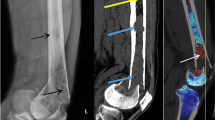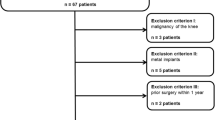Abstract
The purpose of this study is to describe our initial clinical experience with dual-energy computed tomography (DECT) virtual non-calcium (VNC) images for the detection of bone marrow (BM) edema in patients with suspected hip fracture following trauma. Twenty-five patients presented to the emergency department at a level 1 trauma center between January 1, 2011 and January 1, 2013 with clinical suspicion of hip fracture and normal radiographs were included. All CT scans were performed on a dual-source, dual-energy CT system. VNC images were generated using prototype software and were compared to regular bone reconstructions by two musculoskeletal radiologists in consensus. Radiological and/or clinical diagnosis of fracture at 30-day follow-up was used as the reference standard. Twenty-one patients were found to have DECT-VNC signs of bone marrow edema. Eighteen of these 21 patients were true positive and three were false positive. A concordant fracture was clearly seen on bone reconstruction images in 15 of the 18 true positive cases. In three cases, DECT-VNC was positive for bone marrow edema where bone reconstruction CT images were negative. Four patients demonstrated no DECT-VNC signs of bone marrow edema: two cases were true negative, two cases were false negative. When compared with the gold standard of hip fracture determined at retrospective follow-up, the sensitivity of DECT-VNC images of the hip was 90 %, specificity was 40 %, positive predictive value was 86 %, and negative predictive value was 50 %. Our initial experience would suggest that DECT-VNC is highly sensitive but poorly specific in the diagnosis of hip fractures in patients with normal radiographs. The value of DECT-VNC primarily lies in its ability to help detect fractures which may be subtle or undetectable on bone reconstruction CT images.



Similar content being viewed by others
References
Ensrud KE (2013) Epidemiology of fracture risk with advancing age. J Gerontol A Biol Sci Med Sci 68(10):1236–1242
Erb RE (2001) Current concepts in imaging the adult hip. Clin Sports Med 20(4):661–696
Bogost GA, Lizerbram EK, Crues JV 3rd (1995) MR imaging in evaluation of suspected hip fracture: frequency of unsuspected bone and soft-tissue injury. Radiology 197(1):263–267
Sauser DD, Billimoria PE, Rouse GA, Mudge K (1980) CT evaluation of hip trauma. AJR 135(2):269–274
Chana R, Noorani A, Ashwood N, Chatterji U, Healy J, Baird P (2006) The role of MRI in the diagnosis of proximal femoral fractures in the elderly. Injury 37(2):185–186
Nicolaou S, Liang T, Murphy DT, Korzan JR, Ouellette H, Munk P (2012) Dual energy CT: a promising new technique for assessment of the musculoskeletal system. AJR 199(5 Suppl):S78–S86
Pache G, Krauss B, Strohm P, Saueressig U, Blanke P, Bulla S (2010) Dual-energy CT virtual noncalcium technique: detecting post-traumatic bone marrow lesions: feasibility study. Radiology 256(2):617–624
Thiryayi WA, Thiryayi SA, Freemont AJ (2008) Histopathological perspective on bone marrow edema, reactive bone change and hemorrhage. Eur J Radiol 67(1):62–67
Johnson TR (2012) Dual energy CT: general principles. AJR 199(5 Suppl):S3–S8
Guggenberger R, Gnannt R, Hodler J, Krauss B, Wanner GA, Csuka E et al (2012) Diagnostic performance of dual-energy CT for the detection of traumatic bone marrow lesions in the ankle: comparison with MR imaging. Radiology 264(1):164–173
Wang CK, Tsai JM, Chuang MT, Wang MT, Huang KY, Lin RM (2013) Bone marrow edema in vertebral compression fractures: detection with dual energy ct. Radiology 269(2):525–533
Barr M, Anderson M (2002) The knee: bone marrow abnormalities. Radiol Clin North Am 40(5):1109–1120
Reiter M, O'Brien SD, Bui-Mansfield LT, Alderete J (2013) Greater trochanteric fracture with occult intertrochanteric extension. Emerg Radiol 20(5):469–472
Andrews C (2000) From the RSNA refresher courses. Evaluation of the marrow space in the adult hip. Radiographics. Spec No S27-42
Conflict of interest
The authors declare that they have no conflict of interest.
Author information
Authors and Affiliations
Corresponding author
Rights and permissions
About this article
Cite this article
Reddy, T., McLaughlin, P.D., Mallinson, P.I. et al. Detection of occult, undisplaced hip fractures with a dual-energy CT algorithm targeted to detection of bone marrow edema. Emerg Radiol 22, 25–29 (2015). https://doi.org/10.1007/s10140-014-1249-6
Received:
Accepted:
Published:
Issue Date:
DOI: https://doi.org/10.1007/s10140-014-1249-6




